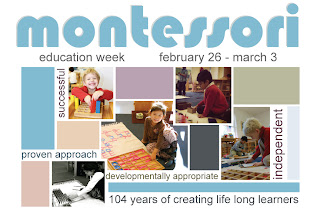Taken from
The Montessori Revolution in Education by E. M. Standing
1. It is based on years of patient observation of the child nature.
2.
It has proved itself of universal application. Within a single
generation it has been tried with complete success with children of
almost every civilized nation. Race, color, climate, nationality,
social rank, type of civilization – all these make no difference to its
successful application.
3. It has revealed the small child as a
lover of work, intellectual work, spontaneously chosen and carried out
with profound joy.
4. It is based on the child’s imperious need
to learn by doing. At each stage in the child’s mental growth,
corresponding occupations are proved by means of which he develops his
faculties.
5. While it offers the child a maximum of spontaneity,
it never-the less enables him to reach the same, or even a higher,
level of scholastic attainment as under the old systems.
6.
Though it does away with the necessity of coercion by means of rewards
and punishments, it achieves a higher discipline than formerly. It is
an active discipline which originates within the child and it is not
imposed from without.
7. It is based on a profound respect for
the child’s personality and removes from him the preponderating
influence of the adult, thus leaving him room to grow in biological
independence. Hence the child is allowed a large measure of liberty
(not license) which forms the basis of real discipline.
8. It
enables the teacher to deal with each child individually in each
subject, and thus guide him according to his individual requirements.
9.
Each child works at his own pace. Hence the quick child is not held
back by the slow, nor is the latter, in trying to keep up with the
former, obliged to flounder along hopelessly out of his depth. Each
stone in mental edifice is “well and truly laid” before the next is
added.
10. It does away with the competitive spirit of its train
of baneful results. More than this, at every turn it presents endless
opportunities among the children for mutual help – which is joyfully
given and gratefully received.
11. Since the child works from his
own free choice, without competition and coercion, he is freed from
danger of overstrain, feelings of inferiority, and other experiences
which are apt to be the unconscious cause of profound mental
disturbances in later life.
12. Finally, the Montessori Method
develops the whole personality of the child, not merely his intellectual
faculties but also his powers of deliberation, initiative and
independent choice, with their emotional complements. By living as a
free member of a real social community, the child is trained in those
fundamental social qualities which form the basis of good citizenship.
.jpg) Children “learn by doing” and that is a key element in the Montessori Method.
Children “learn by doing” and that is a key element in the Montessori Method.  The children absorb a limitless wealth of impressions, taking in all of the elements of the world around them. This lays a foundation for the love of learning for years to come.
The children absorb a limitless wealth of impressions, taking in all of the elements of the world around them. This lays a foundation for the love of learning for years to come.

.JPG)







.JPG)























